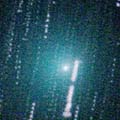
|
Recovered after 117 year blank since 1889. This time it will be closer to the earth than at the discovery, and observable in good condition. It has been getting brighter and larger very rapidly since mid July. Now it is so bright as 8.5 mag, with a diameter of 10 arcmin or larger (July 22, Juan Jose Gonzalez). Now it locates very high in the evening sky. It keeps observable in good condition at 8-9 mag until September in the Northern Hemisphere. However, because it is very close to the earth, it looks diffuse.
Date(TT) R.A. (2000) Decl. Delta r Elong. m1 Best Time(A, h)
Aug. 12 16 51.95 41 31.1 0.434 1.139 95 8.5 20:25 (126, 77)
Aug. 19 16 53.99 47 59.3 0.467 1.118 90 8.5 20:15 (141, 71)
|
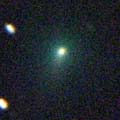
|
New comet discovered on the SWAN images. It was observed in the Southern Hemisphere in July, but now it is not observable. It was very bright as 9.6 mag visually on July 20 (David Seargent). It was about 10.0 mag in SOHO LASCO images on Aug. 15, almost bright as expected. In the Northern Hemisphere, it will appear at 7.5 mag in the extremely low sky at dawn in late September. It will turn to locate in the evening sky after early October. Then it keeps observable in the evening sky until early January while fading gradually. In the Southern Hemisphere, it cannot be observable until next April when it becomes fainter than 15 mag.
Date(TT) R.A. (2000) Decl. Delta r Elong. m1 Best Time(A, h)
Aug. 12 9 47.01 8 46.9 2.178 1.184 8 10.4 20:25 (116,-19)
Aug. 19 9 58.22 11 23.7 2.105 1.095 2 10.0 20:15 (119,-18)
|
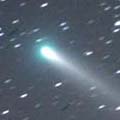
|
It reached to 6 mag at best in early May at the remarkable approach to the earth, when it became double naked eye comets with the component B around the zenith. Now it is going away from the earth and fading. It has already faded down to 11.3 mag (Aug. 4, Juan Jose Gonzalez).
Date(TT) R.A. (2000) Decl. Delta r Elong. m1 Best Time(A, h)
Aug. 12 2 24.52 -13 35.2 0.588 1.320 108 10.8 3:43 (335, 38)
Aug. 19 2 20.03 -14 18.4 0.607 1.384 115 11.0 3:51 (347, 40)
|
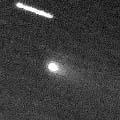
|
It is brightening as expected, and it is already visible visually. Now it is 11.9 mag (Aug. 4, Juan Jose Gonzalez). It will be brightening rapidly after this, and will reach to 8.5 mag from autumn to winter, and observable in its best condition. It keeps 14 mag still in 2007 April, so it keeps visible visually for a long time.
Date(TT) R.A. (2000) Decl. Delta r Elong. m1 Best Time(A, h)
Aug. 12 1 17.92 14 29.2 1.243 1.912 115 11.2 3:43 (350, 69)
Aug. 19 1 27.21 14 57.2 1.158 1.881 119 10.9 3:39 ( 0, 70)
|

|
It reached up to 10.3 mag on July 7 (Juan Jose Gonzalez). Then it is fading gradually. Now it is 11.9 mag (July 28, Katsumi Yoshimoto). It keeps very low, only about 15 degree high until September in the Northern Hemisphere. When it gets higher again, it will be fainter than 14 mag, too faint to see visually.
Date(TT) R.A. (2000) Decl. Delta r Elong. m1 Best Time(A, h)
Aug. 12 19 39.54 -41 42.4 0.754 1.686 144 11.5 22:16 ( 0, 13)
Aug. 19 19 43.12 -40 58.6 0.807 1.712 140 11.8 21:52 ( 0, 14)
|
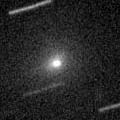
|
It brightened much more rapidly than expected after late April, and reached to 9.5 mag on June 15 (Willian Souza). Now it is 10.8 mag (July 20, Carlos Labordena). It is fading now, but it keeps observable in the evening until autumn when it becomes too faint to see. It keeps locating around 30 degree high.
Date(TT) R.A. (2000) Decl. Delta r Elong. m1 Best Time(A, h)
Aug. 12 14 27.74 -4 52.3 1.102 1.323 77 11.6 20:25 ( 60, 28)
Aug. 19 14 55.24 -7 49.9 1.167 1.377 78 12.0 20:15 ( 55, 28)
|
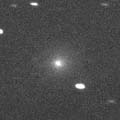
|
The condition is worst in this time, not visible in the Northern Hemisphere at all. It was observed in the Southern Hemisphere as 11.4 mag on June 6, as bright as expected (Michael Mattiazzo). However, in this appearance, the comet will never be observable again.
Date(TT) R.A. (2000) Decl. Delta r Elong. m1 Best Time(A, h)
Aug. 12 9 44.12 15 31.1 2.004 0.996 4 12.5 20:25 (121,-15)
Aug. 19 10 10.24 13 26.0 2.103 1.097 4 13.0 20:15 (118,-14)
|
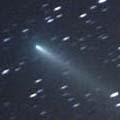
|
It reached to 5 mag at best in early May at the remarkable approach to the earth, when it became double naked eye comets with the component C around the zenith. Now it is going away from the earth and fading. It has already faded down to 12.2 mag visually (July 21, Carlos Labordena), or 15.9 mag by CCD (Aug. 4, Katsumi Yoshimoto). It is very diffuse, and it will be too hard to see visually soon. Ken-ichi Kadota and Masayuki Suzuki reported that the nucleus seemed to have continued small outbursts still in July.
Date(TT) R.A. (2000) Decl. Delta r Elong. m1 Best Time(A, h)
Aug. 12 2 23.74 -14 20.6 0.571 1.311 108 13.0 3:43 (335, 37)
Aug. 19 2 18.82 -15 4.1 0.591 1.375 115 13.4 3:51 (347, 39)
|

|
New comet just discovered on June 14. It is bright as 12.6 mag and visible visually (June 21, Juan Jose Gonzalez). In the Northern Hemisphere, it locates rather low in the evening. In the Southern Hemisphere, it locates high. It will be observable at 13 mag for a long time after this.
Date(TT) R.A. (2000) Decl. Delta r Elong. m1 Best Time(A, h)
Aug. 12 14 10.54 -9 39.1 2.381 2.329 74 13.1 20:25 ( 60, 22)
Aug. 19 14 13.54 -7 35.6 2.464 2.287 68 13.1 20:15 ( 64, 21)
|

|
It had been observed at 10 mag in the evening sky from winter to spring. Although it has been unobservable since May, it will appear in the morning sky again soon. It will come to locate high in October, then it will be visible visually again at 14 mag.
Date(TT) R.A. (2000) Decl. Delta r Elong. m1 Best Time(A, h)
Aug. 12 8 15.06 30 43.0 3.594 2.687 22 13.5 3:43 (235, 4)
Aug. 19 8 27.54 30 2.1 3.629 2.755 26 13.6 3:51 (239, 8)
|

|
Since it appeared in the morning sky in early July, it has been bright as 12 mag and visible visually. It is 12.4 mag still now (Aug. 4, Juan Jose Gonzalez). It will be observable in good condition in autumn and winter.
Date(TT) R.A. (2000) Decl. Delta r Elong. m1 Best Time(A, h)
Aug. 12 4 13.31 30 4.7 6.055 5.830 72 13.7 3:43 (263, 50)
Aug. 19 4 16.61 30 20.8 5.952 5.832 78 13.6 3:51 (267, 57)
|

|
It has been visible at 13.5 mag for a long time since last autumn until spring. But it is already very low in the evening sky. It will be too low to observe soon. However, it will be observable in good condition again at 14.5 mag in next winter.
Date(TT) R.A. (2000) Decl. Delta r Elong. m1 Best Time(A, h)
Aug. 12 11 8.88 33 13.0 6.132 5.274 29 14.3 20:25 (123, 11)
Aug. 19 11 16.03 32 16.5 6.163 5.283 27 14.3 20:15 (123, 9)
|

|
It has been lost since its discovery in 1986. The condition is good in this return. In calculation, it will be 14 mag from autumn to winter. However, it was probably in outburst and brightened unexpectedly at the discovery. So it can be much fainer than this ephemeris actually. In the Northern Hemisphere, it keeps observable until it fades out in next spring.
Date(TT) R.A. (2000) Decl. Delta r Elong. m1 Best Time(A, h)
Aug. 12 17 23.82 -22 40.6 1.034 1.796 122 14.9 20:25 ( 7, 32)
Aug. 19 17 26.06 -22 34.9 1.050 1.753 116 14.8 20:15 ( 11, 32)
|

|
Although it had been asteroidal for about one year since 2005 July, the cometary activity was detected in late July in 2006. But actually, it is almost stellar now. In the Northern Hemisphere, it keeps good condition after this. It keeps locating high until next spring. Now it is 15.2 mag (Aug. 4, Ken-ichi Kadota). The light curve had been completely asteroidal so far. However, it can brighten rapidly as a comet after this, and it may reach to 11 mag in winter.
Date(TT) R.A. (2000) Decl. Delta r Elong. m1 Best Time(A, h)
Aug. 12 22 32.59 17 17.4 1.342 2.241 143 15.1 1:13 ( 0, 72)
Aug. 19 22 23.56 19 29.1 1.255 2.173 146 14.9 0:36 ( 0, 74)
|

|
In 2005 spring, it reached to 14 mag and became visible visually as 13.8 mag (July 8, Reinder J. Bouma). It is in the same condition again this year, but somewhat low. It was visible visually at 13.5 mag in early August (Maciej Reszelsk).
Date(TT) R.A. (2000) Decl. Delta r Elong. m1 Best Time(A, h)
Aug. 12 22 38.16 -22 7.0 2.269 3.246 161 15.0 1:18 ( 0, 33)
Aug. 19 22 33.64 -22 36.8 2.266 3.258 166 15.0 0:46 ( 0, 32)
|

|
It was observed as 12 mag in spring. It was diffuse visually, but bright and enjoyable with a large telescope. It was still bright as 12.8 mag on June 25 (Carlos Labordena). However, it is fading rapidly now. It keeps observable in good condition until autumn, but it will be too faint to see visually soon.
Date(TT) R.A. (2000) Decl. Delta r Elong. m1 Best Time(A, h)
Aug. 12 15 20.37 29 15.2 2.817 2.849 81 15.3 20:25 ( 90, 58)
Aug. 19 15 18.95 28 38.4 2.978 2.916 76 15.5 20:15 ( 92, 54)
|

|
It was in major outburst unexpectedly and reached to 10.5 mag in its last appearance in 1999. It was already recovered in 2005 October. But it has not been observed for about 1 year since that. So the current brightness is quite uncertain. It will appear in the morning sky at 15.5 mag in September, then it will fade out gradually. But actually, it can be much fainter than this ephemeris.
Date(TT) R.A. (2000) Decl. Delta r Elong. m1 Best Time(A, h)
Aug. 12 8 29.70 23 34.9 2.711 1.757 15 15.3 3:43 (239, -3)
Aug. 19 8 49.28 22 4.8 2.696 1.758 17 15.3 3:51 (242, -1)
|

|
It is outside of Jupiter's orbit, so it keeps observable for a long time. In 2006, it is still faint and locating somewhat low. But in 2007 and 2008, it is expected to be bright as 14.5-15 mag. It will locate high at that time, so it may be visible visually.
Date(TT) R.A. (2000) Decl. Delta r Elong. m1 Best Time(A, h)
Aug. 12 19 5.14 -23 35.6 5.862 6.724 145 15.7 21:41 ( 0, 31)
Aug. 19 18 59.03 -23 21.1 5.914 6.698 137 15.7 21:08 ( 0, 32)
|

|
Appearing at dawn. It will be observable at 15.5 mag for a long time from September to January.
Date(TT) R.A. (2000) Decl. Delta r Elong. m1 Best Time(A, h)
Aug. 12 6 12.63 29 32.9 2.129 1.611 46 16.4 3:43 (251, 26)
Aug. 19 6 35.28 28 30.4 2.083 1.598 48 16.2 3:51 (253, 28)
|

|
It is getting higher in the morning sky. It keeps observable at 17 mag in good condition after this until October.
Date(TT) R.A. (2000) Decl. Delta r Elong. m1 Best Time(A, h)
Aug. 12 23 56.29 -7 10.8 1.635 2.514 142 16.8 2:36 ( 0, 48)
Aug. 19 23 53.29 -6 53.8 1.608 2.534 149 16.8 2:06 ( 0, 48)
|

|
It was 16.0 mag on Mar. 13 (Ken-ichi Kadota). It kept 16-16.5 mag for about one year from early 2005. It keeps 17 mag until autumn.
Date(TT) R.A. (2000) Decl. Delta r Elong. m1 Best Time(A, h)
Aug. 12 0 58.25 53 28.5 3.306 3.587 97 16.9 3:38 (180, 71)
Aug. 19 0 52.39 52 50.1 3.240 3.617 103 16.9 3:05 (180, 72)
|

|
It was observed at 17 mag in 2005 summer. It will reach to 17 mag again in 2006 summer.
Date(TT) R.A. (2000) Decl. Delta r Elong. m1 Best Time(A, h)
Aug. 12 22 47.19 -10 44.6 2.345 3.314 159 17.1 1:27 ( 0, 44)
Aug. 19 22 43.39 -11 23.9 2.328 3.323 167 17.1 0:56 ( 0, 44)
|
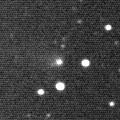
|
It was bright as 15 mag in 2004 and 2005. Now it is far away from the sun, but it still observable at 17 mag in 2006.
Date(TT) R.A. (2000) Decl. Delta r Elong. m1 Best Time(A, h)
Aug. 12 1 15.48 -12 30.9 3.314 3.976 124 17.1 3:43 (356, 42)
Aug. 19 1 14.49 -13 1.7 3.257 3.993 130 17.1 3:26 ( 0, 42)
|
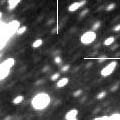
|
It keeps 17 mag for a long time after this until the end of 2007. It will be observable in good condition in 2006 autumn and 2007 autumn.
Date(TT) R.A. (2000) Decl. Delta r Elong. m1 Best Time(A, h)
Aug. 12 19 30.28 48 38.4 3.442 3.925 111 17.1 22:06 (180, 76)
Aug. 19 19 26.96 48 20.8 3.424 3.900 110 17.1 21:36 (180, 77)
|

|
It is outside of Jupiter's orbit. So it keeps 16.5-17.5 mag for a long time until 2008. In 2006, it keeps observable in good condition until November.
Date(TT) R.A. (2000) Decl. Delta r Elong. m1 Best Time(A, h)
Aug. 12 21 23.38 -15 44.9 5.312 6.325 179 17.1 0:04 ( 0, 39)
Aug. 19 21 16.61 -15 34.0 5.305 6.307 170 17.1 23:25 ( 0, 39)
|

|
It will be observable at 17 mag in good condition in September and October. Then it will fade out rapidly, and will be fainter than 18 mag in December.
Date(TT) R.A. (2000) Decl. Delta r Elong. m1 Best Time(A, h)
Aug. 12 3 2.43 18 42.9 2.260 2.486 90 17.2 3:43 (294, 59)
Aug. 19 3 8.83 18 24.9 2.196 2.512 95 17.2 3:51 (304, 64)
|

|
It was unexpectedly bright as 15.5 mag on Apr. 2 (Ken-ichi Kadota). Although it had been very low until June, now it is getting higher. It is already fading now. However, I has ever become a naked eye object in outburst, so observations are encouraged.
Date(TT) R.A. (2000) Decl. Delta r Elong. m1 Best Time(A, h)
Aug. 12 0 38.21 -10 3.5 1.423 2.240 132 17.3 3:18 ( 0, 45)
Aug. 19 0 36.50 -11 4.2 1.411 2.280 139 17.4 2:49 ( 0, 44)
|

|
It reached to 6 mag in 2004. It had been visible visually until January. It is appearing at dawn after a blank of half a year. It will be already very faint as 17 mag. It will be fading slowly around 17-18 mag until December.
Date(TT) R.A. (2000) Decl. Delta r Elong. m1 Best Time(A, h)
Aug. 12 3 9.85 -0 53.7 7.373 7.514 94 17.3 3:43 (314, 44)
Aug. 19 3 8.77 -1 8.8 7.316 7.572 100 17.3 3:51 (325, 48)
|
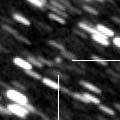
|
It will reach to 14.5 mag in 2007 summer, but it will be observable only in the Southern Hemisphere at that time. In the Northern Hemisphere, it keeps observable at 17.5 mag in good condition until autumn.
Date(TT) R.A. (2000) Decl. Delta r Elong. m1 Best Time(A, h)
Aug. 12 19 56.23 8 31.6 4.477 5.360 147 17.5 22:32 ( 0, 63)
Aug. 19 19 50.16 7 17.6 4.464 5.313 143 17.5 21:59 ( 0, 62)
|

|
It was observed at 17 mag in late 2005. In 2006, it will be observable at 17.5 mag in autumn.
Date(TT) R.A. (2000) Decl. Delta r Elong. m1 Best Time(A, h)
Aug. 12 3 4.75 24 26.5 5.251 5.321 88 17.6 3:43 (284, 62)
Aug. 19 3 0.70 24 34.0 5.131 5.333 96 17.6 3:51 (295, 69)
|

|
It has not been observed in this apparition yet. But now it must be brightening rapidly. The condition of this apparition is excellent. It will reach to 15.5 mag in October and November.
Date(TT) R.A. (2000) Decl. Delta r Elong. m1 Best Time(A, h)
Aug. 12 3 0.96 1 12.0 1.251 1.687 95 17.9 3:43 (315, 47)
Aug. 19 3 14.24 3 26.8 1.166 1.652 98 17.6 3:51 (320, 51)
|

|
It was 17.6 mag on July 23 (Filip Fratev). It will brighten after the perihelion passage. It will reach to 15.5 mag and will be observable in good condition from November to January.
Date(TT) R.A. (2000) Decl. Delta r Elong. m1 Best Time(A, h)
Aug. 12 4 11.01 13 36.9 1.818 1.852 75 17.9 3:43 (285, 43)
Aug. 19 4 26.03 14 5.1 1.762 1.855 78 17.7 3:51 (289, 47)
|
|
![]()
 P/2006 HR30 ( Siding Spring )
P/2006 HR30 ( Siding Spring ) 117P/Helin-Roman-Alu 1
117P/Helin-Roman-Alu 1 C/2004 B1 ( LINEAR )
C/2004 B1 ( LINEAR ) 52P/Harrington-Abell
52P/Harrington-Abell C/2005 L3 ( McNaught )
C/2005 L3 ( McNaught ) 114P/Wiseman-Skiff
114P/Wiseman-Skiff P/2006 H1 ( McNaught )
P/2006 H1 ( McNaught ) C/2005 B1 ( Christensen )
C/2005 B1 ( Christensen ) P/2005 L1 ( McNaught )
P/2005 L1 ( McNaught ) P/2004 F3 ( NEAT )
P/2004 F3 ( NEAT ) C/2006 M1 ( LINEAR )
C/2006 M1 ( LINEAR ) C/2005 S4 ( McNaught )
C/2005 S4 ( McNaught ) P/2005 JY126 ( Catalina )
P/2005 JY126 ( Catalina ) 98P/Takamizawa
98P/Takamizawa C/2003 K4 ( LINEAR )
C/2003 K4 ( LINEAR ) C/2006 K4 ( NEAT )
C/2006 K4 ( NEAT ) C/2005 R4 ( LINEAR )
C/2005 R4 ( LINEAR ) 112P/Urata-Niijima
112P/Urata-Niijima 84P/Giclas
84P/Giclas![]()




















